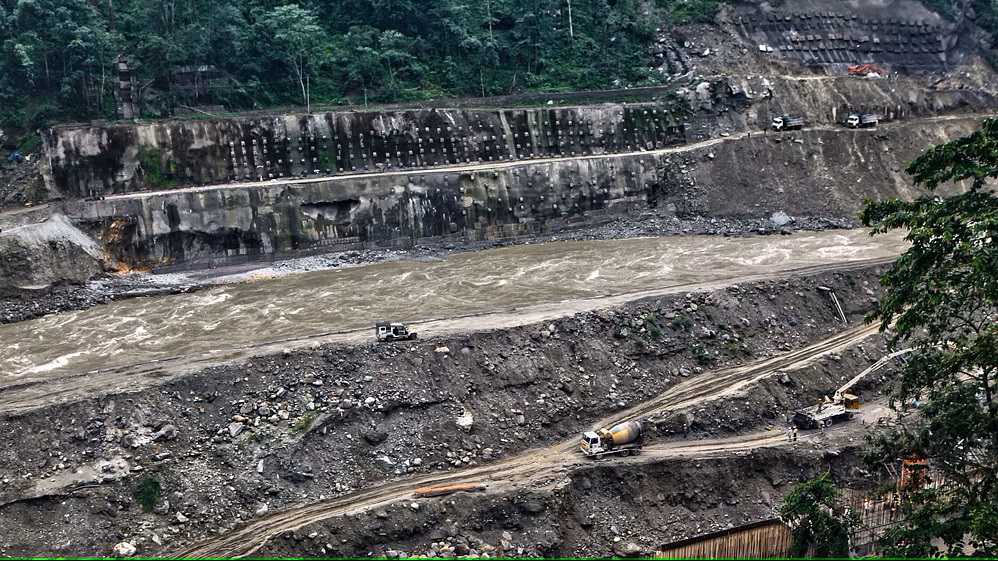More Small Hydel Projects In Hills Has Ministry For Environment Worried
Oct 15, 2023 | Shalini Rai
The Union Environment Ministry has said that smaller hydropower projects with capacities below 5 MW in hill states such as Sikkim, Uttarakhand and Himachal Pradesh have the potential to disrupt the natural flow of rivulets and adversely impact upon aquatic fauna (photo: Creative Touch Imaging Ltd./NurPhoto via Getty Images)
Raising concerns over the increasing number of proposals for smaller hydropower projects with capacities below 5 MW in hill states such as Sikkim, Uttarakhand and Himachal Pradesh, the Union Environment Ministry has said that these have the potential to disrupt the natural flow of rivulets and adversely impact upon aquatic fauna.
On September 11, the Union Environment Ministry’s Forest Advisory Committee discussed the issue in a meeting; its minutes were recently made available. The panel recalled that in 2011, the ministry had directed all states to carry out capacity studies for their river basins and to conduct cumulative impact assessment studies.
The panel also noted that such studies have been successfully completed across five states for only 13 river basins so far.
According to the Forest Advisory Committee, these comprehensive studies cover a range of factors, including an evaluation of environmental consequences, biodiversity implications, management of muck disposal sites, traffic management in the region and addressing issues related to rehabilitation and resettlement. The purpose of such studies is to gauge the cumulative impact of hydropower projects within a river basin.
The panel opined that although most cumulative assessment studies primarily emphasise hydropower projects with installed capacities exceeding 25MW, they also cover projects with capacities of 5MW and above.
Therefore, the committee expressed concern over the increasing number of proposals for smaller hydropower projects, especially those with capacities below 5MW. This applies particularly to hill states like Himachal Pradesh, Uttarakhand, Sikkim and Arunachal Pradesh.
It said that rivers and their smaller tributaries have become focal points for such projects, but there are no commensurate studies on their impact.
The minutes of the meeting read, “Even smaller projects on third-order tributaries may impede the natural flow of (a) rivulet and thereby impact the aquatic fauna, as these projects are of smaller installed capacity but their number is relatively higher.”
Therefore, the impact can affect species such as masheer and trout, that rely on these waters for breeding, the committee noted.
The committee also acknowledged the challenges in assessing the impact of these smaller projects due to the absence of long-term plans from state governments and credible assessments of their influence on aquatic ecosystems and hydrological regimes.
The panel decided to revisit the issue in the upcoming committee meeting and seek expert opinion from the impact assessment division of the ministry since the matter falls under its purview.
Environmental Impact Assessment (EIA) is the assessment of the environmental consequences of a plan, policy, program, or actual projects prior to the decision to move forward with the proposed action.
In this context, the term “environmental impact assessment” is usually used when applied to actual projects by individuals or companies and the term “strategic environmental assessment” (SEA) applies to policies, plans and programmes most often proposed by organs of state. It is a tool of environmental management forming a part of project approval and decision-making.
Environmental assessments may be governed by rules of administrative procedure regarding public participation and documentation of decision making, and may be subject to judicial review.
The purpose of the assessment is to ensure that decision-makers consider the environmental impacts when deciding whether or not to proceed with a project.
The International Association for Impact Assessment (IAIA) defines an environmental impact assessment as “the process of identifying, predicting, evaluating and mitigating the biophysical, social, and other relevant effects of development proposals prior to major decisions being taken and commitments made”.
EIAs are unique in that they do not require adherence to a predetermined environmental outcome, but rather they require decision-makers to account for environmental values in their decisions and to justify those decisions in light of detailed environmental studies and public comments on the potential environmental impacts.
